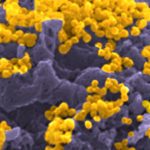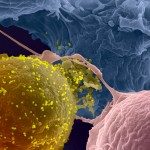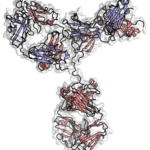Lien vers Pubmed [PMID] – 28122982
J. Virol. 2017 Apr;91(8)
Anti-human immunodeficiency virus type 1 (HIV-1) nonneutralizing antibodies (nnAbs) capable of antibody-dependent cellular cytotoxicity (ADCC) have been identified as a protective immune correlate in the RV144 vaccine efficacy trial. Broadly neutralizing antibodies (bNAbs) also mediate ADCC in cell culture and rely on their Fc region for optimal efficacy in animal models. Here, we selected 9 monoclonal nnAbs and 5 potent bNAbs targeting various epitopes and conformations of the gp120/41 complex and analyzed the potency of the two types of antibodies to bind and eliminate HIV-1-infected cells in culture. Regardless of their neutralizing activity, most of the selected antibodies recognized and killed cells infected with two laboratory-adapted HIV-1 strains. Some nnAbs also bound bystander cells that may have captured viral proteins. However, in contrast to the bNAbs, the nnAbs bound poorly to reactivated infected cells from 8 HIV-positive individuals and did not mediate effective ADCC against these cells. The nnAbs also inefficiently recognize cells infected with 8 different transmitted-founder (T/F) isolates. The addition of a synthetic CD4 mimetic enhanced the binding and killing efficacy of some of the nnAbs in an epitope-dependent manner without reaching the levels achieved by the most potent bNAbs. Overall, our data reveal important qualitative and quantitative differences between nnAbs and bNAbs in their ADCC capacity and strongly suggest that the breadth of recognition of HIV-1 by nnAbs is narrow.IMPORTANCE Most of the anti-HIV antibodies generated by infected individuals do not display potent neutralizing activities. These nonneutralizing antibodies (nnAbs) with antibody-dependent cellular cytotoxicity (ADCC) have been identified as a protective immune correlate in the RV144 vaccine efficacy trial. However, in primate models, the nnAbs do not protect against simian-human immunodeficiency virus (SHIV) acquisition. Thus, the role of nnAbs with ADCC activity in protection from infection remains debatable. In contrast, broadly neutralizing antibodies (bNAbs) neutralize a large array of viral strains and mediate ADCC in cell culture. We analyzed the capacities of 9 nnAbs and 5 bNAbs to eliminate infected cells. We selected 18 HIV-1 strains, including virus reactivated from the reservoir of HIV-positive individuals and transmitted-founder isolates. We report that the nnAbs bind poorly to cells infected with primary HIV-1 strains and do not mediate potent ADCC. Overall, our data show that the breadth of recognition of HIV-1 by nnAbs is narrow.



